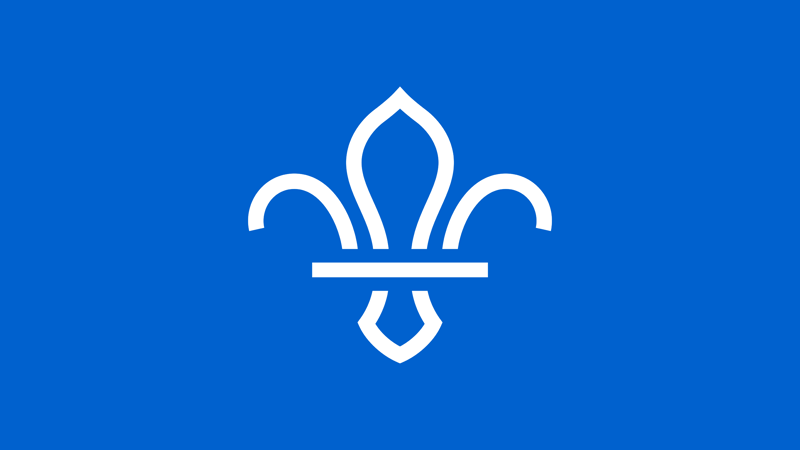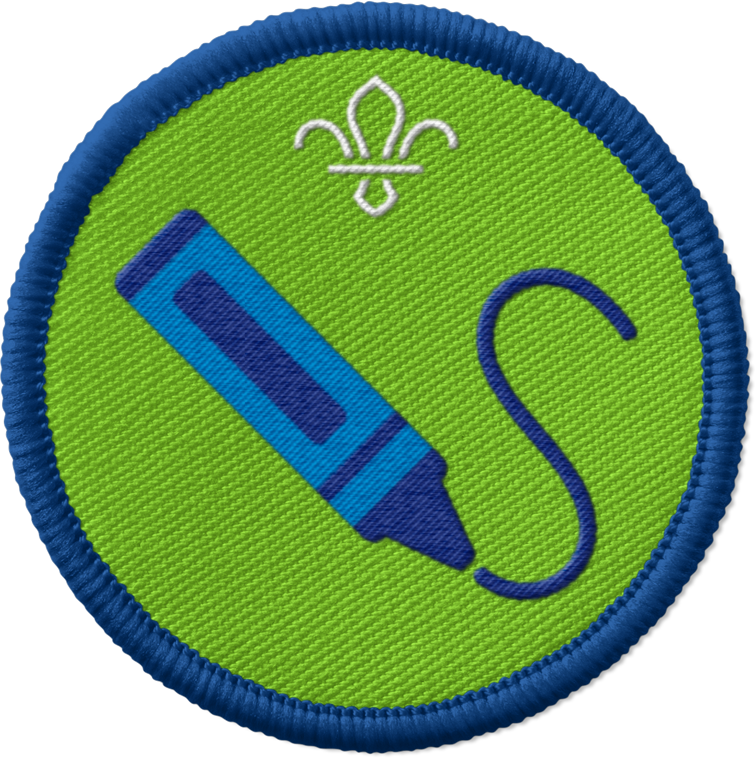
Creative spirit
You’ll need
- Chalk
- Coloured pens or pencils
- Craft materials (for example, tissue paper, pipe cleaners, stickers)
- Device to play music
- Natural materials (for example, leaves, twigs, feathers)
- Something to protect surfaces (for example, newspaper or tablecloths)
- PVA glue
- Scissors
- Paint brushes
- Paint
Before you begin
- Use the safety checklist to help you plan and risk assess your activity. Additional help to carry out your risk assessment, including examples can be found here. Don’t forget to make sure all young people and adults involved in the activity know how to take part safely.
- Make sure you’ll have enough adult helpers. You may need some parents and carers to help if you’re short on helpers.
Planning for this activity
- In this activity, you may choose to visit an outdoor area, so decide where you’ll visit. You should choose somewhere that's full of natural materials that everyone can use to be creative.
- Instead of visiting a location, you could also ask people to bring some natural materials to the meeting.
Story time
- Everyone should sit in a circle.
- Someone should read Splat! by Jess Connett. An adult could help with reading the story.
- After they’ve heard the story, everyone should take some time to talk about it as a group. We’ve included some questions to help you reflect in the pink box below.
Ali and Sara were in the garden, painting pictures on big pieces of paper.
Ali loved drawing. He could colour in really neatly. In his bedroom, his parents had pinned up his favourite drawings: a big red fox with beady black eyes, and a fish that was all the colours of the rainbow.
Sara didn’t have any paints at home. She liked to build things with bricks. She and her brothers would try to build the tallest towers, or create a bridge that was strong enough to walk over.
Ali was already filling his paper with squiggles and swirls. ‘I’m doing an octopus,’ he said. ‘She’s going to be wearing a jumper that has eight arms!’
Sara’s page was still empty. She just didn’t know what to draw.
‘This is hard,’ she said. ‘I haven’t got any ideas.’
‘What about drawing your family?’ said Ali. ‘Or your dream house. Or an aeroplane and all the people going on holiday!’ Ali had so many ideas that it was hard to focus on just one.
Sara’s brain felt empty. She felt sad that she couldn’t think of something like Ali could.
She stood up and accidentally knocked over the paint tray. SPLAT! Now there was a spotty line of blue paint right down the page.
‘Oh no!’ said Sara. ‘I’ve ruined it! I’ll have to crumple it up.’
‘No, don’t!’ said Ali. ‘You can make it into something. If you turn the page around it looks like the windows on a tall building.’
Sara turned the page. Oh yes, she could see that! She picked up the paintbrush and made the windows round. Now it was a spaceship, and in the windows were the astronauts, waving to Earth.
Now her lines were going higher, and the drawing turned into the tallest tower in the world – it was bursting out of the sky and into space, until it bumped against the moon. Sara added supports to stop it falling over.
‘That’s a really good design,’ she said. ‘I’ll remember it when I next play with bricks. Thanks, Ali. I’m glad I didn’t crumple up my page, or I might never have built a tower to the moon.’
By Jess Connett
Look around
- Gather everyone in a circle and explain that being creative isn’t always about making a beautiful picture or an impressive sculpture. Sometimes, it’s about enjoying the process of being creative and not worrying too much about what you create.
- Tell everyone that in this activity the goal is for people to be as creative as they want to be. It doesn’t matter what the end result looks like, as long as people enjoy making it.
- Either outside the meeting place, or from the items brought in, everyone should spend about five minutes collecting all of the natural items they think they’d to use in their creative art.
- Everyone should look around at all of the natural materials they could use. You could create a calm environment by listening to some relaxing music while people explore and investigate them.
- People should start to think about how they could use these natural items to be creative. They should use all their senses to explore the items. They could close their eyes to feel them, use their nose to smell them, see how they feel to touch or see if they look like a familiar shape.
- They should use their imaginations to think about how they could be used to make art. For example, people might be curious about how it feels to drag a stick through some squelchy mud or use it as a paintbrush, or they might wonder what would happen if they crumbled some dry leaves between their fingers and let them float to the card.
Take your time
- Everyone should find a space where they feel comfortable to create their own individual art.
- Let everyone use the items. Everyone should begin to create and explore the natural materials. It’s time to get stuck in!
- You could put on some relaxing music while everyone makes their artwork.
- Tell everyone when there are five minutes before the end of the session so they have time to finish being creative, tidy up, and put the natural items back where they found them.
Bring the art together and talk
- When they're finished, give everyone some time to show off the artwork that they created and chatting about how it felt to be creative. We’ve included some questions to help you reflect in the pink box below.
- Everyone should try to focus on how people felt when they were making their artwork, rather than what it looks like.
- They could make objective comments. Objective comments are based on facts and not people's opinions. Some examples of objective comments could be ‘I can see where the mud went’ or ‘The leaves are yellow, like the sun’.
- People could also ask open ended questions, such as ‘Can you tell me what you used to paint your picture?’ or 'Why did you decide to glue leaves there?'.
- Remind everyone that this activity isn’t about the end product, it’s all about how it feels to be creative. Therefore, everyone should try not to make subjective comments about the picture. Subjective comments are your own opinions and views. Some examples of subjective comments might be how much you like the final product or whether it looks like something else, such as a house or a face.
Reflection
This activity encouraged everyone to be mindful as they were creative with natural materials. Mindfulness is about being aware of what you’re sensing and feeling in the moment, without judging it. In this activity, the focus wasn’t on the quality or amount of artwork everyone produced – what mattered was how they enjoyed the process of being creative.
You can chat about the reflection questions below throughout the session or at the end.
Story time
- Why didn’t Sara want to do any artwork at the start?
- How did Sara feel at the end of the Story? Why?
Look around
- What do the natural materials around everyone look, smell, and feel like?
- How does everyone feel walking around in this natural environment?
Take your time
- How did everyone feel while they were creating their artwork?
- How does everyone feel when they looked at each other’s artwork?
Safety
All activities must be safely managed. You must complete a thorough risk assessment and take appropriate steps to reduce risk. Use the safety checklist to help you plan and risk assess your activity. Always get approval for the activity, and have suitable supervision and an InTouch process.
- Glue and solvents
Always supervise young people appropriately when they’re using glue and solvent products. Make sure there’s plenty of ventilation. Be aware of any medical conditions that could be affected by glue or solvent use and make adjustments as needed.
- Outdoor activities
You must have permission to use the location. Always check the weather forecast, and inform parents and carers of any change in venue.
- Scissors
Supervise young people appropriately when they’re using scissors. Store all sharp objects securely, out of the reach of young people.
- Sharp objects
Teach young people how to use sharp objects safely. Supervise them appropriately throughout. Store all sharp objects securely, out of the reach of young people.
If some people are finding the activity too challenging, you could share some examples of mindful artwork to encourage them.
You could show people examples of art that famous artists have made, such as Pablo Picasso or Gustav Klimt. Can people use the art to inspire them?
It’s best if everyone has the chance to go outside and explore natural materials in their local area. If this isn’t possible, such as because of the weather or where you meet, everyone could collect materials for the group to use during the session.
Some people might find it a bit strange to be creative in this way. They might not know where to begin. Try to provide some emotional support to build their confidence.
All Scout activities should be inclusive and accessible.
People could keep being creative and make some artwork at home. They could even bring it to another session so they can share their new creations with each other.
Encouraged everyone to explore and try to individually create some art without an adult helping them. It doesn’t matter how big or small their creation is, or what it looks like – it’s all about the process.
